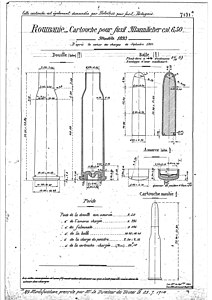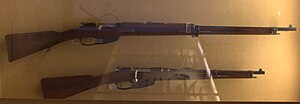|
6.5×53mmR
The 6.5×53mmR, originally and more correctly produced as the 6.5×53.5mmR, and in imperial system nomenclature known as the .256 Mannlicher, is a late 19th-century rimmed centerfire military rifle cartridge similar to other early smokeless powder designs. History and descriptionIt's generally assumed that Mannlicher derived his 6.5 mm cartridge from an experimental 6.5 mm rimmed Luigi Scotti design, a precursor of the 6.5×52mm Carcano, which was provided to him by the Italian government in 1890 in order to build a rifle for it.[8][9] Mannlicher's Model 1891 rifle was adopted by Romania in 1892 as the Mannlicher M1893 and the Netherlands in 1895. They used the first of a series of 6.5-millimetre (0.26 in) Mannlicher cartridges[1] which became the standard service rifle cartridge for the Romanian Mannlicher M1893 from 1893 to 1938,[2] and the Dutch Geweer M. 95 from 1895 to 1945.[3] Dutch ammunition with cartridge cases made of brass (pre-occupation) or steel (under German occupation) may be encountered on the American surplus market. In both instances, the primer pocket is Berdan-style, of an unusual type (Roth-patent), and features a central flash hole running through the center of the integral Berdan anvil. When examining fired cases from the inside with a flashlight, this design gives the false impression of a Boxer primed cartridge case. Portugal's Navy adopted this cartridge for the Mannlicher Model 1896, officially known as "Espingarda Portuguesa Mod. 1896".[10] It was also used by artillery and cavalry units of the Esercito. It was used only shortly until the adoption of the Mauser-Vergueiro, and most were then sent to the colonies. The AE (Arsenal do Esercito) made "M96" 6,5x53R ammo well into the 1930s.[11] This is the original rimmed or "flanged" cartridge designed by Steyr-Mannlicher for the Romanian and the Dutch military. In the family of Mannlicher cartridges, it is directly related to and the precursor of the later Greek 6.5×54mm Mannlicher–Schönauer rimless cartridge with which it is ballistically identical.[12] In the military service rifles, these cartridges are loaded primarily by using the Mannlicher designed en-bloc clip as used in the German Gewehr 1888 "Commission" rifle. These pre-date and are similar in concept to the clip used later by the US Army's M1 Garand. With the Ferdinand Mannlicher designed trigger guard / magazine housing assembly, when the bolt is open and fully retracted to the rear the full en-bloc clip is loaded into the magazine from the top through the open receiver. The empty clip will fall out through a hole in the base of the magazine housing when out of cartridges, enabling quick reloading of the rifles during combat. Also when the bolt is fully open, full clips can be vigorously ejected upwards from the magazine housing by means of a spring loaded latch at the rear of the magazine, operated by a recessed button in the front of the trigger guard portion of the assembly. The clips were essentially disposable as ammunition would be issued already loaded into clips from the factory. The .256 Mannlicher cartridge also saw use as a sporting round. The elephant hunter W. D. M. Bell was fond of a Mannlicher M1893 rifle in .256 Mannlicher, (from renowned English gunmaker George Gibbs), that he used to hunt for meat in Africa.[13] Additional case dimensions Based on direct measurement of Dutch and German unfired ammunition averaged and compared to published original sources:[14][15]
Surplus WW2 and earlier ammunition is still available on the collector market, but these are primarily corrosive in nature and rifles fired using it will require a thorough cleaning to reduce the development of rust. 6.5x53mmR caliber pre-WW2 Dutch and Romanian rifles are still commonly available on the collector and surplus markets, and sport and recreational shooters can still enjoy using these "early modern rifles". Due to very close dimensional relationships, boxer-primed cartridge cases can be made by resizing and trimming .303 British[16] or .30-40 Krag (.30-40 US)[17] brass, and Fire forming the resulting altered brass cases in the 6.5x53R chamber. Alteration of the original 6.5×53mmR caliber chamber by re-chambering the rifle barrel with a 6.5x57R[18] (see:6.5×57mm Mauser) chamber reamer has also been done, but the overall length of the original 6.5×53mmR Dutch or Romanian cartridge has to be maintained by seating the projectile more deeply into the cartridge case to fit the original magazine. In this case, it would also be best practice to retain the C.I.P. 6.5×57mmR[18] upper pressure limit of 3300 Bar to reduce any additional stress on these 80 to 125 year old rifles. Gallery
See also
References
|
|||||||||||||||||||||||||||||||||||||||||||||||||||||||||||||||||||||||||||||||||||









